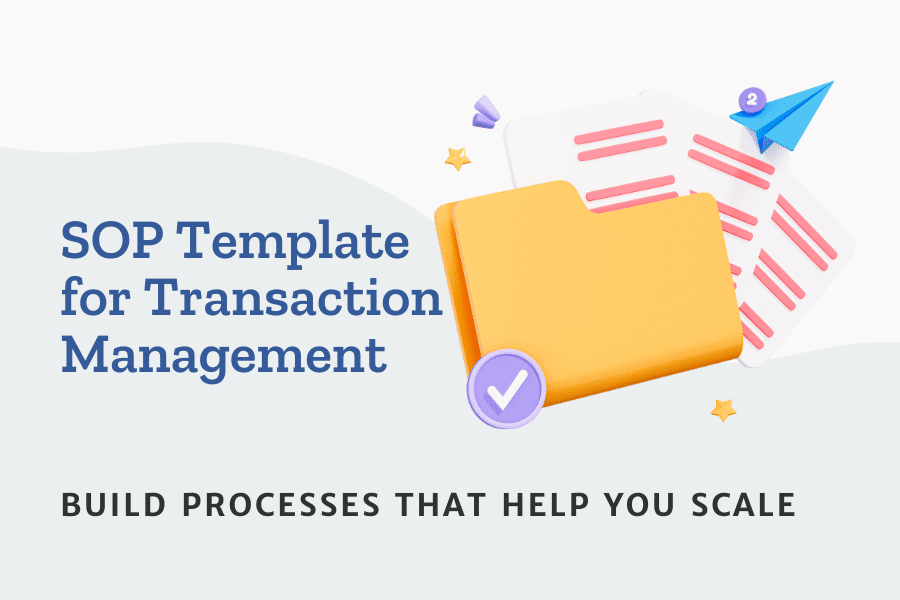
Are you looking to systematize your processes as you scale your real estate team? As the backbone of the transaction process, coordinators are responsible for managing numerous details, deadlines, and documents. Given the complexity and volume of these tasks, having a Standard Operating Procedure (SOP) is essential for maintaining consistency, efficiency, and quality control within your business.
An SOP serves as a comprehensive guide that outlines the exact steps and procedures needed to complete tasks accurately and consistently. For transaction coordinators, a well-developed SOP can mean the difference between a seamless closing and a chaotic, error-ridden process. It provides a clear roadmap for both experienced team members and newcomers, ensuring that everyone knows what needs to be done, when, and how.
In this blog, we will explore the importance of having an SOP for transaction coordinators and how it can benefit your business. We’ll delve into the basics of SOPs, how to assess and document your current processes, and the steps to draft, review, and implement an effective SOP. Additionally, we’ll discuss how ListedKit’s transaction templates can play a crucial role in ensuring consistency, especially when bringing new team members on board. By adding notes with instructions and conditional due dates, you can make sure anyone involved in your transactions knows exactly what they need to do and in what order.
Understanding the Basics of SOPs in Real Estate
A Standard Operating Procedure (SOP) is a comprehensive, written set of instructions designed to standardize the performance of a specific function. For transaction coordinators, an SOP outlines the steps necessary to manage real estate transactions efficiently and consistently. It ensures that every team member follows the same process, leading to uniform and high-quality outcomes.
Key Components of an SOP
- Purpose: Explains why the SOP exists and its objectives. It provides context for the procedures, emphasizing the importance of consistency and quality.
- Scope: Defines the boundaries of the SOP, specifying the processes and activities it covers. This section clarifies the applicable tasks and transactions, ensuring there is no ambiguity about its use.
- Procedures: The heart of the SOP, detailing the step-by-step instructions for completing each task. Procedures should be clear and concise, ensuring they are easy to follow for anyone, regardless of their experience level.
- Roles and Responsibilities: Outlines who is responsible for each task within the SOP. This section assigns specific roles, ensuring accountability and preventing overlap or confusion.
Download our sample SOP template for transaction management
How SOPs Contribute to Streamlined Operations and Reduced Errors
SOPs are essential for enhancing the efficiency and reliability of transaction coordination processes. Here are the key benefits:
- Consistency: SOPs standardize procedures, ensuring that every team member follows the same steps. This is especially useful for onboarding new staff, as it provides clear instructions and expectations.
- Efficiency: Well-defined procedures reduce the time and effort required to complete tasks. Team members can work more efficiently with clear guidance, minimizing the need for supervision and corrections.
- Quality Control: SOPs maintain high-quality standards by ensuring tasks are performed uniformly. This reduces the likelihood of errors and omissions, leading to more reliable outcomes.
- Training Tool: SOPs serve as excellent training resources for new employees. Detailed instructions and role-specific responsibilities help new team members integrate quickly and effectively.
- Accountability: Defined roles and responsibilities ensure each team member knows their duties. This fosters accountability and helps identify and address performance issues effectively.
Incorporating SOPs into your transaction coordination processes can significantly improve your business’s efficiency and reliability. ListedKit’s transaction templates can assist in creating and managing these SOPs by providing a framework for adding notes, instructions, and conditional due dates. This ensures that all team members, whether experienced or new, have the guidance they need to perform their tasks correctly and consistently.
By understanding the basics of SOPs and their key components, you can establish a more organized, efficient, and error-free transaction coordination process. In the next section, we’ll explore how to assess your current processes to identify areas for improvement and begin developing your own SOPs.
Conducting a Process Audit
Before you can develop an effective Standard Operating Procedure (SOP), it’s essential to understand your current workflows and procedures. A process audit involves a thorough review of all existing tasks and practices related to transaction coordination. Here’s how to conduct an effective process audit:
Identify Existing Workflows and Procedures
Start by mapping out all the tasks involved in a typical real estate transaction. This includes everything from initial client contact to final closing. Document each step in the process, noting who is responsible for each task and how long it typically takes.
Gather Input from Team Members and Stakeholders
Your team members and stakeholders are invaluable sources of information. They can provide insights into the daily challenges and inefficiencies they encounter. Conduct interviews or surveys to gather their input, ensuring you capture a comprehensive view of the current processes.
Document Current Practices
Create detailed documentation of your current workflows. This should include step-by-step descriptions of each task, the tools and resources used, and any relevant forms or templates. The ListedKit template library allows you to turn these into streamlined workflows that your teams can use. This allows you to turn processes into actionable SOPs. Learn more here.
Gathering Input from Team Members and Stakeholders
Engaging with your team and stakeholders is crucial for a successful process audit. Here are some strategies to gather valuable input:
1. Interviews: Conduct one-on-one interviews with team members to discuss their roles and responsibilities. Ask them to describe their daily tasks, the challenges they face, and any suggestions they have for improving efficiency.
2. Surveys: Distribute surveys to collect feedback from a larger group. Use open-ended questions to encourage detailed responses. For example, ask about specific pain points in the transaction process or suggestions for streamlining tasks.
3. Workshops: Organize workshops or focus groups where team members can collaborate and share their experiences. These sessions can foster open discussions and generate innovative ideas for improving processes.
Documenting Current Practices and Pinpointing Areas for Improvement
Once you have gathered input and documented your current processes, it’s time to analyze the information and identify areas for improvement. Here’s how to proceed:
1. Review and Analyze Data: Examine the documentation and feedback to identify common themes and recurring issues. Look for bottlenecks, redundancies, and tasks that are prone to errors.
2. Pinpoint Areas for Improvement: Based on your analysis, identify specific areas where changes can enhance efficiency and reduce errors. This could include automating repetitive tasks, clarifying roles and responsibilities, or streamlining communication channels.
3. Prioritize Changes: Determine which improvements will have the most significant impact on your transaction coordination processes. Prioritize these changes and outline a plan for implementing them in your SOP.
By conducting a thorough process audit, gathering input from your team, and documenting current practices, you can gain a clear understanding of your existing workflows. This foundational knowledge is crucial for developing an effective SOP that addresses inefficiencies and enhances the overall quality of your transaction coordination processes.
In the next section, we will discuss how to define clear objectives and goals for your SOP, ensuring it aligns with your overall business objectives and sets measurable targets for success.
Defining Clear Objectives and Goals
Creating a Standard Operating Procedure (SOP) is not just about documenting processes—it’s about achieving specific, meaningful objectives that enhance your transaction coordination operations. Start by clearly defining what you aim to accomplish with your SOP. Consider the following goals:
- Consistency: Ensure that every transaction follows the same standardized procedures, leading to uniform outcomes and reducing the likelihood of errors.
- Efficiency: Streamline tasks to save time and resources, enabling your team to handle more transactions with the same or fewer efforts.
- Quality Control: Maintain high standards by setting clear guidelines and expectations, ensuring that every transaction meets your quality benchmarks.
- Training: Facilitate onboarding and training for new team members by providing them with a comprehensive guide to your transaction processes.
- Compliance: Ensure that all transactions adhere to legal and regulatory requirements, reducing the risk of non-compliance issues.
Aligning SOP Goals with Overall Business Objectives
To maximize the impact of your SOP, align its goals with your broader business objectives. This ensures that your SOP supports your company’s mission and strategic direction. Here’s how to align SOP goals with business objectives:
- Identify Business Objectives: Review your company’s mission, vision, and strategic goals. Identify key business objectives that are relevant to your transaction coordination processes, such as improving customer satisfaction, increasing transaction volume, or enhancing team productivity.
- Map SOP Goals to Business Objectives: For each SOP goal, determine how it supports your business objectives. For example, improving consistency and efficiency can directly contribute to higher customer satisfaction and increased transaction volume.
- Communicate Alignment: Ensure that all team members understand how the SOP’s goals align with the company’s broader objectives. This helps to foster a sense of purpose and commitment to following the SOP.
By defining clear objectives and goals for your SOP and aligning them with your overall business objectives, you can create a powerful tool that enhances your transaction coordination processes. In the next section, we will discuss how to draft your SOP, including outlining its structure and writing clear, concise procedures for each task.
Drafting an SOP for Transaction Management
A well-organized SOP should have a clear and logical structure. Here’s a recommended outline for your SOP:
- Title Page: The title page should include the title of the SOP, the date of creation, the author(s), and the version number. This helps keep track of updates and revisions.
- Table of Contents: A table of contents makes it easy for users to navigate the document. List all the main sections and subsections with corresponding page numbers.
- Introduction: The introduction should provide an overview of the SOP’s purpose and scope. Explain the importance of the SOP and how it will benefit the team. Include any relevant background information that provides context.
- Procedures: This is the core of the SOP, detailing the step-by-step instructions for each task involved in managing real estate transactions. Break down the procedures into clear, manageable steps.
- Appendices: Include any additional information that supports the SOP, such as templates, forms, checklists, and reference materials. This section can also contain a glossary of terms used in the SOP.
Writing Clear and Concise Procedures for Each Task
When drafting the procedures, ensure that the instructions are clear, concise, and easy to follow. Here are some tips for writing effective procedures:
- Use Simple Language: Avoid jargon and complex language. Write in simple, straightforward sentences that are easy to understand.
- Be Specific: Provide detailed instructions for each step, specifying who is responsible for each task and any tools or resources required.
- Use Active Voice: Write in the active voice to make the instructions more direct and easier to follow.
Example: Step-by-Step Guide for Managing Client Communication
- Initiate Contact: Contact the client via email or phone within 24 hours of receiving the transaction file. Use the initial contact template provided in the appendices.
- Schedule Introduction Meeting: Arrange a meeting with the client to discuss the transaction process, timelines, and any specific requirements.
- Send Welcome Packet: Email the client a welcome packet that includes an overview of the transaction process, key contacts, and important dates.
- Regular Updates: Provide the client with regular updates throughout the transaction. Schedule weekly check-ins and send progress reports every Friday.
Example: Detailed Process for Document Management and Storage
- Document Collection: Collect all necessary documents from the client, including signed contracts, disclosure forms, and inspection reports.
- File Naming: Name each document according to the standardized naming convention outlined in the appendices (e.g., “ClientName_Contract_Date.pdf”).
- Upload to System: Upload all documents to the transaction management system within 48 hours of receipt.
- Organize Files: Organize the files into designated folders based on the type of document and stage of the transaction.
- Backup and Security: Ensure that all documents are backed up to a secure server and that access is restricted to authorized personnel only.
Using Visual Aids like Flowcharts and Checklists to Enhance Clarity
Visual aids can significantly enhance the clarity and usability of your SOP. Consider incorporating the following:
- Flowcharts: Use flowcharts to map out the steps in a process visually. This helps users understand the sequence of tasks and decision points more easily.
- Checklists: Include checklists for key tasks to ensure that no steps are missed. Checklists are particularly useful for complex processes that involve multiple steps and stakeholders.
- Diagrams and Tables: Use diagrams and tables to present information clearly and concisely. For example, a table can summarize key dates and deadlines, while a diagram can illustrate the document flow within the transaction process.
By outlining the structure of your SOP, writing clear and concise procedures, and using visual aids, you can create an effective SOP that enhances your real estate transaction management processes. In the next section, we will discuss how to review and test your SOP to ensure it is accurate and practical.
Implementing an SOP for Transaction Management
Creating a comprehensive Standard Operating Procedure (SOP) is only the first step. Effective implementation ensures that the SOP achieves its intended goals. This section will guide you through training your team, ensuring role clarity, and providing necessary resources and support for a smooth adoption.
Training the Team on the New SOP
Training is crucial to ensure that all team members understand and can effectively follow the new SOP. Here are some steps to conduct effective training:
- Conduct Training Sessions: Organize formal training sessions where you walk the team through the SOP. Explain the purpose of the SOP, its benefits, and how it aligns with overall business objectives.
- Interactive Workshops: Hold interactive workshops to allow team members to practice the procedures outlined in the SOP. Use real-life scenarios and role-playing exercises to make the training engaging and practical.
- Provide Training Materials: Distribute training materials such as handouts, guides, and videos that team members can refer to after the sessions. Ensure these materials are easily accessible.
- Offer One-on-One Support: For team members who need additional help, provide one-on-one support. This can be in the form of coaching sessions or mentorship from more experienced colleagues.
- Regular Refresher Courses: Schedule regular refresher courses to reinforce the SOP and keep everyone up-to-date with any changes or improvements.
Ensuring Everyone Understands Their Roles and Responsibilities
Clarity about roles and responsibilities is essential for the successful implementation of the SOP. Here’s how to ensure everyone understands their roles:
- Role-Specific Training: Tailor training sessions to address the specific responsibilities of different roles. For example, train transaction coordinators on task management and client communication, while training administrative staff on document management and storage.
- Detailed Job Descriptions: Provide detailed job descriptions that outline each team member’s role and responsibilities concerning the SOP. This helps avoid confusion and ensures accountability.
- Regular Check-Ins: Hold regular check-ins with team members to discuss their roles and responsibilities. Use these meetings to address any questions or concerns and provide additional guidance if needed.
- Visual Aids: Use organizational charts and flowcharts to visually represent roles and responsibilities. This can help team members understand how their tasks fit into the overall transaction process.
Providing Resources and Support for Smooth Adoption
Support and resources are critical to help your team smoothly transition to the new SOP. Consider the following steps:
- Accessible Documentation: Ensure that the SOP and all related documents are easily accessible to all team members. Use a central repository or document management system where they can find everything they need.
- Help Desk or Support Team: Establish a help desk or support team to assist with any questions or issues that arise during the implementation phase. Ensure that team members know how to contact this support.
- Feedback Mechanism: Implement a feedback mechanism where team members can provide input on the SOP. This can be through surveys, suggestion boxes, or regular team meetings. Use this feedback to make necessary adjustments and improvements.
- Incentives and Recognition: Recognize and reward team members who effectively follow the SOP and contribute to its successful implementation. This can motivate others to adopt the SOP more willingly.
- Continuous Improvement: Encourage a culture of continuous improvement where team members are always looking for ways to enhance the SOP and transaction processes. Regularly review and update the SOP based on feedback and changing needs.
By thoroughly training your team, clarifying roles and responsibilities, and providing robust support and resources, you can ensure a smooth and effective implementation of your SOP. In the next section, we will discuss how to monitor and update the SOP to keep it relevant and effective over time.
Monitoring and Updating the SOP
To keep your Standard Operating Procedure (SOP) effective and up-to-date, it’s crucial to regularly monitor and update it. Here’s how:
Regular Reviews
- Set Review Dates: Schedule regular reviews (e.g., quarterly or annually) to ensure the SOP remains relevant.
- Assign Responsibility: Designate specific team members to oversee the review process.
- Create a Review Calendar: Share a calendar with the team to keep everyone informed of upcoming reviews.
- Track Changes: Maintain a log of updates to document all modifications.
Collecting Feedback
- Establish Feedback Channels: Use surveys, suggestion boxes, and team meetings to gather input from users.
- Encourage Open Communication: Foster an environment where team members feel comfortable providing feedback.
- Regular Check-Ins: Hold periodic meetings to discuss the SOP and gather insights.
- Analyze Input: Identify common themes and prioritize critical issues for improvement.
Making Improvements
- Implement Changes: Update the SOP based on feedback and review findings to enhance efficiency and clarity.
- Test Updates: Pilot changes to ensure they work effectively before full implementation.
- Update Training Materials: Reflect SOP changes in all training resources and provide updated training to the team.
- Leverage Technology: Incorporate new tools like ListedKit to streamline processes.
- Monitor Continuously: Regularly assess the SOP’s effectiveness using performance metrics and KPIs.
- Encourage Innovation: Motivate team members to suggest improvements and reward valuable contributions.
By regularly reviewing the SOP, collecting ongoing feedback, and making iterative improvements, you can ensure that your SOP remains a dynamic and effective tool for managing real estate transactions. This approach will help your team adapt to changing needs and technologies, maintaining high standards of efficiency and quality.
Closing Thoughts
Developing a Standard Operating Procedure (SOP) is crucial for transaction coordinators to streamline processes, boost efficiency, and maintain high standards of quality. An SOP ensures consistency and reduces errors, making it easier to onboard new team members.
Start creating or refining your SOP today with our transaction management sample. A well-documented SOP will improve your transaction processes and overall team productivity.
ListedKit’s transaction templates can help ensure consistency, especially when bringing new team members on board. With notes, instructions, and conditional due dates, ListedKit helps everyone stay on track.



